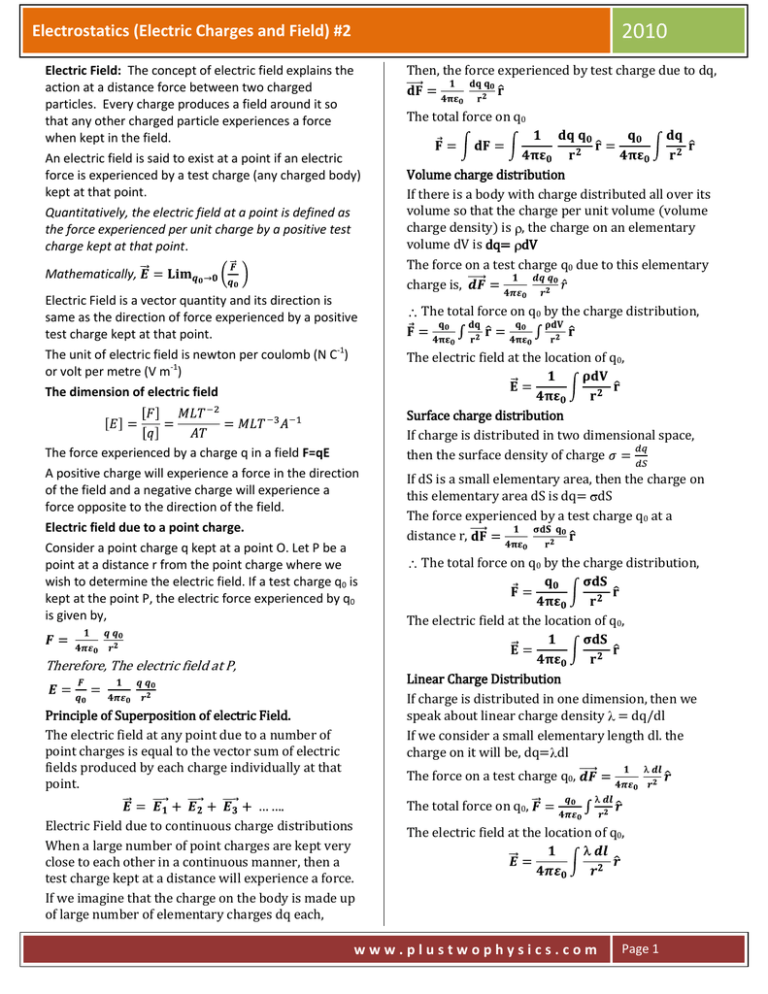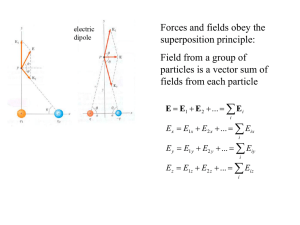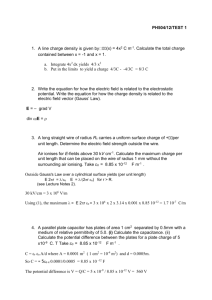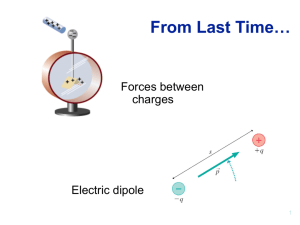2010 Electrostatics (Electric Charges and Field) #2
advertisement

2010 Electrostatics (Electric Charges and Field) #2 Electric Field: The concept of electric field explains the action at a distance force between two charged particles. Every charge produces a field around it so that any other charged particle experiences a force when kept in the field. An electric field is said to exist at a point if an electric force is experienced by a test charge (any charged body) kept at that point. Quantitatively, the electric field at a point is defined as the force experienced per unit charge by a positive test charge kept at that point. Mathematically, Electric Field is a vector quantity and its direction is same as the direction of force experienced by a positive test charge kept at that point. The unit of electric field is newton per coulomb (N C-1) or volt per metre (V m-1) The dimension of electric field The force experienced by a charge q in a field F=qE A positive charge will experience a force in the direction of the field and a negative charge will experience a force opposite to the direction of the field. Electric field due to a point charge. Consider a point charge q kept at a point O. Let P be a point at a distance r from the point charge where we wish to determine the electric field. If a test charge q0 is kept at the point P, the electric force experienced by q0 is given by, Therefore, The electric field at P, Then, the force experienced by test charge due to dq, The total force on q0 Volume charge distribution If there is a body with charge distributed all over its volume so that the charge per unit volume (volume charge density) is , the charge on an elementary volume dV is dq= dV The force on a test charge q0 due to this elementary charge is, The total force on q0 by the charge distribution, The electric field at the location of q0, Surface charge distribution If charge is distributed in two dimensional space, then the surface density of charge If dS is a small elementary area, then the charge on this elementary area dS is dq= dS The force experienced by a test charge q0 at a distance r, The total force on q0 by the charge distribution, The electric field at the location of q0, Linear Charge Distribution If charge is distributed in one dimension, then we speak about linear charge density = dq/dl If we consider a small elementary length dl. the charge on it will be, dq= dl Principle of Superposition of electric Field. The electric field at any point due to a number of point charges is equal to the vector sum of electric fields produced by each charge individually at that point. The force on a test charge q0, The total force on q0, Electric Field due to continuous charge distributions When a large number of point charges are kept very close to each other in a continuous manner, then a test charge kept at a distance will experience a force. If we imagine that the charge on the body is made up of large number of elementary charges dq each, The electric field at the location of q0, www.plustwophysics.com Page 1 2010 Electrostatics (Electric Charges and Field) #2 Electric Dipole: An electric dipole is a pair of equal and opposite charges +q and –q separated by a small distance 2l Dipole moment (P) is the product of either charge and the distance between the two point charges. Electric dipole moment is a vector quantity and is directed from negative charge to positive charge. Unit of electric dipole moment is coulomb metre (C m) Electric Field due to a dipole (a) Axial Position Consider a dipole formed by two charges ±q separated by a distance 2l. Let P be a point on the axial line at a distance r from the centre of the dipole. r A (–q) O B (+q) EA P EB The electric field at P due to charge (-q) at A is towards left and is given by (along EB EB Sin C EA Cos EB Cos EA EA Sin A (-q) B (+q) Resolving EA and EB in mutually perpendicular components, the vertical components EA sin and EB sin cancel out being equal in magnitude and opposite in direction. The horizontal components EA cos and EB cos add up. The resultant electric field on the equatorial position, But, PA) The electric field at P due to charge (+q) at B is towards right and is given by (along For a short dipole r>>l and l2 in denominator can be neglected in comparison to r2 Parallel to the dipole BP) So, the resultant electric field at P will be towards right since EB > EA Eaxial = EB - EA = moment and opposite in direction (c) Any position (short dipole) Consider an electric dipole of dipole moment P. Let C be a point at a distance r (>>l). The line joining the centre of the dipole and the point C make an angle C with the axis of the dipole. Rearranging, 2lq = P, the electric dipole moment of the dipole. , For a short dipole r>>l and l2 in denominator can be neglected in comparison to r2 In the direction of dipole moment (b) Equatorial Position Consider a dipole formed by two charges ±q separated by a distance 2l. Let C be a point on the equatorial line at a distance r from the centre of the dipole. The electric field at the point C due to (-q) at A is along CA (towards A) and the electric field at C due to (+q) at B is along BC (away from B). The two fields are equal in magnitude but act in different directions. P cos P P sin The dipole moment P can be resolved in to two mutually perpendicular components Pcos and Psin . For the component Pcos C is axial position and for the component P sin C is equatorial position. Let the components of electric field at C be Ell and E www.plustwophysics.com Page 2 2010 Electrostatics (Electric Charges and Field) #2 Since they are mutually perpendicular, the resultant electric field at C, On axial position, =0, and cos =1 On equatorial position =90 , and cos =0 Torque on a dipole in a uniform electric field Consider a dipole formed by two charges ±q separated by a distance 2l placed in a uniform electric field E with its axis making an angle with +q the electric field. qE B 2l cos -q A +q at B experiences a force qE in the The charge qE direction of electric field and the charge –q experiences a force qE opposite the direction of electric field. The forces are equal in magnitude but opposite in direction. Therefore the net force acting on the dipole is zero. But since these equal and opposite forces are parallel to each other separated by a distance, they constitute a couple. The torque (turning effect) of the couple is given by In Vector form, The direction of is perpendicular to both P and E The torque tries to align the dipole moment parallel to the electric field. When =0 , the dipole is in stable equilibrium (net force = 0 and net torque = 0 and the dipole regains its original position when slightly disturbed) and when = 180 , the dipole in unstable equilibrium (net force = 0 and net torque = 0 and the dipole goes further away from its original position when slightly disturbed) Torque is maximum when =90 ; Electric dipole in a non uniform field In a uniform electric field, the force on the two charges of the dipole will be different and therefore the dipole will experience a net force as well as a net torque. Electric field lines Electric field lines are used to represent a field diagrammatically. An electric field line (also called electric lines of force) is an imaginary line in an electric field such that the tangent to it at any point gives the direction of electric field at that point. In an electric field a free positive test charge will move along an electric field line. Properties of electric field line 1. They start from a positive charge and end in a negative charge 2. Field lines are smooth continuous curves without any abrupt changes or breaks. 3. The tangent to it at any point gives the direction of electric field at that point. 4. Electric field lines never intersect each other* 5. They always enter or emerge normal to the surface of a conductor**. 6. They tend to contract longitudinally (on account of attraction between unlike charges) 7. They tend to expand laterally (on account of repulsion between like charges) 8. The relative closeness of field lines indicate the strength of electric field. i.e, Electric field lines are closer in regions of greater electric field and far apart in regions of weaker electric field. *Electric field lines never intersect each other. Why? If they intersect, two tangents can be drawn at the point of intersection indicating two different directions of electric field at the same position which is impossible. **Electric field lines are always normal to the surface of a conductor. Why? If the electric field line is not normal, it can be resolved into two components, a normal component and a tangential component. The tangential component will make the free charges of the conductor to move along the surface of the conductor. But no such movements are observed indicating that there is no tangential component which implies that the electric field lines are always normal to the surface of a conductor. Area vector Area vector of a surface is a vector normal to the surface and whose magnitude is equal to the area of the surface Solid angle The ratio of the area to the square of the magnitude of radius vector is the solid angle subtended by the area. www.plustwophysics.com Page 3 2010 Electrostatics (Electric Charges and Field) #2 The solid angle subtended by an area dS whose radius vector makes and angle with the area vector is dS are in the same direction. , since For an arbitrary surface, the total angle subtented by the surface The total solid angle around a point in free space is 4 strd Electric Flux Electric flux through a surface is a measure of the total number of electric field lines passing normal to the given surface. The electric flyx through and elementary surface of area dS is given by The total electric flux through a surface Electric Flux is a scalar quantity and its unit is Nm2C-1 Gauss Theorem Gauss’ theorem states that the total electric flux through a closed surface (in vacuum) is equal to times the net charge enclosed by the surface. Mathematically, Inside a medium the eqn becomes Applications of Gauss theorem (i) Electric field due to a point charge Consider a point charge q kept at the point O. Let P be a point at a distance r from the point charge. Imagine a Gaussian sphere** passing through P with the charge at O as the centre. Let dS be a small elementary area on the surface of the sphere. Therefore, The electric field at the point, (ii) Electric field due to a line of charge Consider a long straight line of charge of linear charge density . Let P be a point at a distance r from the line of charge. Imagine a Gaussian Cylinder passing through P and with the line of charge as the axis. Let dS be a small elementary surface around the point P. + + + + P + Applying Gauss’ theorem, + + The cylindrical Gaussian surface is composed of three surfaces – two plane surfaces and one curved surface. But =0 for curved surface and 90 for plane surface. Therefore, By symmetry, E is constant throughout the curved surface and q = l, where l is the length (height) of the Gaussian cylinder. Therefore, E But, E , curved surface area of the cylinder OR E = (iii) Electric field due to a plane sheet of charge Consider a plane sheet of charge of surface density of charge . Let P be a point at a distance r from the plane sheet of charge. Imagine a Gaussian cylinder passing through P and symmetric about the plane r P sheet of charge as shown in figure. +q + O + ++ + + ++ + + Applying Gauss theorem, ++ + + ++ + + ++ + + ++ By symmetry, E is constant at any point on the + + + surface of the Gaussian sphere and =0 since E and + Page 4 www.plustwophysics.com 2010 Electrostatics (Electric Charges and Field) #2 Imagine small elementary area dS around P. Applying Gauss Theorem, Therefore, The electric field at the point The cylindrical Gaussian surface is composed of three surfaces – two plane surfaces and one curved surface. But =0 for plane surface and 90 for curved surface. Therefore, By symmetry, E is constant throughout the plane surfaces as we have imagined the two pane surfaces equidistant from the sheet of charge and q = S, where S is the area of cross section of the cylinder and is the area of the plane sheet inside the Gaussian cylinder. Or E is independent of distance (provided the distance is too large compared to the size of the sheet of charge) (iv) Electric field due to a charge spherical conducting shell Consider a charged spherical conducting shell with charge q with centre O. Here, there are three different typical positions for the point P where the electric field can be evaluated. 1. Outside the spherical shell Let P be a point outside the spherical shell at a distance r from the centre of the sphere. Imagine a Gaussian sphere passing through P and concentric with the spherical shell. Let dS be a small elementary area on the surface of the sphere. R +q r Therefore, 3. Inside the spherical shell For a point inside the sphere, the Gaussian surface does not enclose any charge and therefore the Electric field = o According to Gauss Theorem, Here qenclosed =0 Therefore, E = 0 This is applicable for a cavity of any shape. The electric field inside a cavity is always zero The above results are also true for a charged solid conducting sphere as well as a uniformly charged nonconducting spherical shell. Electrostatic Shielding The vanishing of electric field inside a cavity is called electrostatic shielding. The above results are also true for a charged solid conducting sphere as well as a uniformly charged non-conducting spherical shell. Graph showing the variation of electric field with distance from the centre of a charged spherical shell P O Applying Gauss theorem, By symmetry, E is constant at any point on the surface of the Gaussian sphere and =0 since E and dS are in the same direction. , since This value is same as that due to a point charge. Therefore we can say that the charged spherical shell behaves as if the entire charge is concentrated at its centre. 2. On the spherical shell On the spherical shell, r=R. E O R r Q. Why is it safe to be inside the car when you are out in a car during the time of lightning and thunder? Q. Suggest a method to safely carry a highly sensitive electrical instrument through a region of strong and varying electric field. Explain the principle used in the method suggested by you. Q. Why the net charge inside a conductor is always zero? **************************** www.plustwophysics.com Page 5







